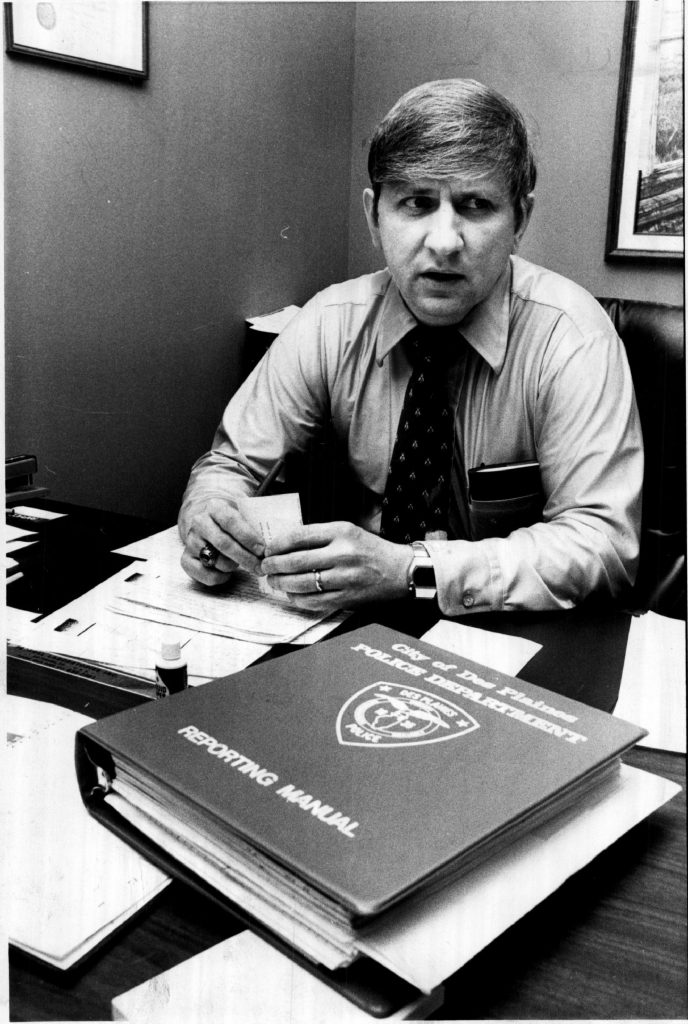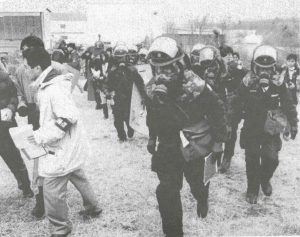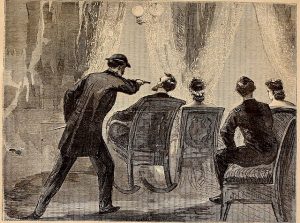Winner of the Fall 2017 StMU History Media Award for
Article with the Best Introduction
It was December 12, 1978. Just as every morning, Chief Detective Joseph Kozenczak sat in his office on the first floor and went over the reports from the past 24 hours. Sipping some coffee, he started off by reading through Monday’s list of events: “a domestic argument which ended with the police restoring peace, a break-in on Phoenix Drive, a report of an abandoned vehicle, several malfunctioning alarms in businesses requiring police assistance to restore, etc.”1 It wasn’t until midway through the list of Monday’s Report when Joseph Kozenczak came across the name Robert Jerome Piest, a missing persons report filed by his mother Elizabeth Piest.2

Joseph Kozenczak had found this to be very interesting because of the narrative part of the report. As described from the report, the mother and son had a very repetitive routine. Elizabeth would pick up her son at 5:30 p.m. after his gymnastics session at Maine West High School in Des Plaines, Illinois. Then she would have his dinner and milk to eat in the car, and he’d usually eat it as Elizabeth drove to Nisson Pharmacy, where Robert worked. But Monday was a bit different. Rob ate a sandwich. Elizabeth had saved her birthday cake to be cut after picking up Rob from work. She arrived at Nisson Pharmacy at 9 p.m., and she went in to get Rob. Rob asked his mother to wait outside so he could discuss a summer job with a construction contractor. Twenty minutes passed and Elizabeth went to check the parking lot only to find that she was alone. There was no sign of Rob, or this mysterious construction contractor. Not knowing who the contractor was, Elizabeth called her son’s friends and one of the owners of the pharmacy, and found out that his name was John Wayne Gacy, Jr.3
Something about the report didn’t seem right to Detective Kozenczak. He knew Robert had no reason to leave his family, or run away from home, so where was he? He read the report one more time. While reading through the report, Detective Kozenczak found that the young boy Robert was born the same year as his own son, as well as the fact that the two boys attended the same high school (Maine West High School).
Detective Kozenczak decided to put “Ronnie” Ron Adams to investigate the Piest missing persons case. He chose Adams because he wasn’t just a good cop, but he also had passion for his job. He knew Adams was the right one for this case. Also Kozenczak knew about the fact that Adams had a family, and had hoped it would make things more personal while continuing the harsh investigation. Adams didn’t waste any time at all. He talked with the two brothers who owned the pharmacy, and found out that the contractor, John Gacy, had been in the store not once, but twice. To check Gacy’s alibi, Adams then called Gacy at 9:15 a.m. and Gacy explained that he had been present at the pharmacy, but only because of some remodeling plans, and to gather or see if there were any tools he needed. He also said, “He had not spoken, nor had any personal contact with the missing boy.” It was at this point that things started to not add up in the mind of Detective Kozenczak.4

The investigation “wasn’t getting anywhere fast” as Kozenczak put it. It was not until Detective Jim Pickell stepped out of his office, when things started to take off. The two detectives knew about Gacy’s arrest, but did not know exactly what John Wayne Gacy had been arrested for. Pickell went off in search of what Gacy had been arrested for. Pickell was known to get what he wanted, and always did what he had to in order to obtain it.
The two Detectives then read Gacy’s rap sheet, which was filled with numerous crimes, the first and most important: “20 May 1968-Waterloo, Iowa-Sodomy-10 years.” The word “sodomy” stuck into the two detectives’ heads. After going through the rap sheet, the two detectives were both convinced Gacy was deeply involved in the disappearance of Robert Piest.5 Later that day,Detectives Kozenczak, Pickell, Olsen, and Sommerschield went to Gacy’s house to interview him. Kozenczak and Pickell went inside, while Sommerschield and Olsen waited outside on the street. While inside the house, Gacy sat in his recliner, and not much happened except for the same story he gave Adams over the phone. Kozenczak had coaxed Gacy into coming down to the station, and after a few attempts, it finally worked.
Gacy called and came in around noon. He had no problem telling the same story, as well as filling out the witness report; but he did seem agitated after he refused a lie detector test. While that was going on, Kozenczak was gathering his warrant, and on his way back to get Gacy’s keys. At 5 p.m. Kozenczak rushed in to find Gacy and asked for his keys. Gacy was terrified and filled with anger. He fought and argued before he was forced to give up his keys.
As Kozenczak put it, “I put the key in the door and I felt like I was stepping into the unknown.”6 They searched the house and found a crawl space that was creepy, but nothing seriously incriminating; but they did take many things as evidence. They took clothes, papers, towels, shoes, etc. It was not until the third warrant was issued that Detective Kozenczak decided to crawl into the crawl space. That’s when everything changed in the blink of an eye.
When Detective Kozenczak crawled into the muddy crawl space, he was face to face with not one or two, but three bodies. He encountered the three bodies in the first ten minutes he had spent in the crawl space. A call was made, and as soon as the news was told to Gacy about the findings, he admitted to the murders with no hesitation. Once the crime scene was investigated and dug up, and everything was done, the Medical Examiner was called in, and over the course of a few weeks or so, twenty-four more bodies were discovered in the ground beneath Gacy’s crawl space. As reported by Detective Kozenczak, “There was plastic over their heads and most of them were partially clothed. They had been strangled and were in various stages of decomposition. There were skeletons everywhere.”7 But that wasn’t the end of finding bodies. The serial killer admitted that there was not enough room left for his last six victims. With no room left for the bodies, Gacy had turned to the river, dumping his last victim Robert Piest into the Des Plaines river. The river was near the Chicago Airport. Gacy admited to dumping the body in the winter of 1978, although they found his body in late spring of 1979. Robert’s body had froze, and was conserved in ice until it thawed out late spring.

Justice was finally served when Gacy was arrested and found guilty after a long and devastating trial in March 13, 1980. He received multiple sentences. “The jury quickly returned a verdict of guilty on thirty-three counts of murder, twelve carrying a death sentence, and two charges of sexual assault.” The jury did the right thing by putting a heartless monster like Gacy away. Gacy was executed by lethal injection on May 10, 1994, in the Stateville Correctional Center in Joliet, Illinois. Gacy was pronounced dead at 12:58 a.m.8
The ending somehow did not seem to lift the weight off the shoulders of Detective Joseph R. Kozenczak, as he stated “I thought that I would feel that it was all resolved then. But it wasn’t. It was just hard to live with.”9 Someone will never understand what it was like to be in the chase, but we know how hard and personal it was for Detective Joseph R. Kozenczak. After the chase was done and finally put to rest, Kozenczak retired and went on to write his own book, A Chicago Killer, which was a great insight into what the Gacy Case was like. Unfortunately Joseph R. Kozenczak passed away Wednesday May 13, 2015. He had served on the Des Plaines Police team as Chief Detective for 27 years.10 Detective Joseph R. Kozenczak’s passion, strength, and patience will live on longer than we can imagine. He brought justice to 33+ families and their relatives.
- Joseph R. Kozenczak and Karen M. Kozencz, The Chicago Killer: The Hunt For John Wayne Gacy (Xlibris, Corp., 2011), 23. ↵
- Joseph R. Kozenczak and Karen M. Kozencz, The Chicago Killer: The Hunt For John Wayne Gacy (Xlibris, Corp., 2011), 24. ↵
- Joseph R. Kozenczak and Karen M. Kozencz, The Chicago Killer: The Hunt For John Wayne Gacy (Xlibris, Corp., 2011), 25. ↵
- Joseph R. Kozenczak and Karen M. Kozencz, The Chicago Killer: The Hunt For John Wayne Gacy (Xlibris, Corp., 2011), 28. ↵
- Joseph R. Kozenczak and Karen M. Kozencz, The Chicago Killer: The Hunt For John Wayne Gacy (Xlibris, Corp., 2011), 37. ↵
- Joseph R. Kozenczak and Karen M. Kozencz, The Chicago Killer: The Hunt For John Wayne Gacy (Xlibris, Corp., 2011), 58. ↵
- Ginnie Teo, “Sleuth Recalls Viciousness of Killer,” The Straits Times (Singapore, August 1997). ↵
- Debbie Howlett and Sandra Sanchez, “John Wayne Gacy Executed/ Fatal Injection Ends Saga Of Serial Killer,” USA Today, (May 1994): 3. ↵
- Ginnie Teo, “Sleuth Recalls Viciousness of Killer,” The Straits Times (Singapore, August 1997). ↵
- N. Sameer Yacoub, “Detective who led John Wayne Gacy Investigation Dies,” US News Online, May 15, 2015. ↵



117 comments
Julian Aguero
I can’t believe that Gacy got away with so many murders until then. I think it shows how different police enforcement was compared to now. Many children were missing with Gacy as the last person to see them. It’s amazing they would just consider that as a coincidence especially since Gacy had a previous record. Great article really caught my attention when I started to read the background of the Piest family relationship. I have conflictions with the death penalty but a person like Gacy makes me think that some people deserve it.
Lewis Wilson
I’ve heard references to this man. I have been intrigued for ages now I have finally seen in black and white how insane this man really was. Killing 30 people is disgusting and too keep several body’s in his own house as some sort of trophy is disgusting. What I would like to know about more I what is the whole deal with the clown suit. Why I clown suit why not a mask or something more scary?
Maricela Guerra
The crime of this was phenomenal, the way that detective Joseph just didn’t give up and he believed the victims mother and not thinking twice about it. Showing dedication in his work, also the author goes in depth with the investigation of John Wayne. It makes you wonder what kind of a person like John Gacy is. How does one just commit that many crimes and still live life like it was no problem.
Fumei P.
I’ve heard references made to John Wayne Gacy, and I knew he was a psychopath, but I never knew how many people he killed. It must have been a wild chase, because he killed 30 people, and he kept most of the bodies in his home. There are also photos of his clown suit, but no mention of whether or not he used his costume to lure his victims. His actions are heinous and appalling, good riddance.
Kimberly Simmons
This was a very intriguing article. The part about the bodies in Gacy’s home made me shiver – I was beyond disgusted. He absolutely got what he deserved when he was sentenced to lethal injection. Though the families finally got justice, there is no peace that can ever come to a family who has had someone taken away from them. The detective did his job well; his remorse for the dead just shows his compassion for the job.
Peter Coons
Gacy is an infamous figure in the long history of American serial killers. What makes Gacy so much more is his background, his clown get up being the the stuff of nightmares. Gacy, quite literally, was a killer clown. On top of that, having three dozen murders and more than likely the same number of sexual assaults proves the sadistic nature of his being and that the jury was more than right in finding him guilty.
Saira Castellanos
I think that although the detective did bring justice to so many families, sentencing someone to death probably would be a burden. I dont believe they should have let him off by killing him. I think he should have been put in prison for the rest of his life. I think that being in prison for life and even after your death is a better punishment than killing someone. I feel like they are getting away with it. I really liked this article, I thought they really brought the crawl space to life with such great imagery.
Johnanthony Hernandez
I can remember the first time I came across the Gacy Case and how it just worsened my fear of clowns. Probably didn’t help I was only a kid when I first saw the movie that they had made on him. But your article gave more insight to Gacy and the detective that brought him into custody for the things he did.
Alexandra Cantu
I can see why this article won best introduction. In my opinion it was a new take in an opening and I liked it. The name John Wayne Gacy is no secret to me I had read about the way he murdered his victims but I had never heard of it from the law enforcement point of view. It described the hard work it took to catch this serial killer. It must of been such a great arrest to put such a wicked man behind bars and bring the family of the victims to peace.
Jasmine Jaramillo
Before reading this article I had heard the name of John Wayne Gacy but I couldn’t remember who he was. That’s what made this article intriguing to me. As I read the article I could tell just how manipulative Gacy was. He would not tell the truth until the detectives placed the evidence right in front of him. Its scary to think he killed twenty-four people but even more unnerving to think that he buried them under his house. That fact that he wore a clown costume as well just says to me he had severe mental problems.